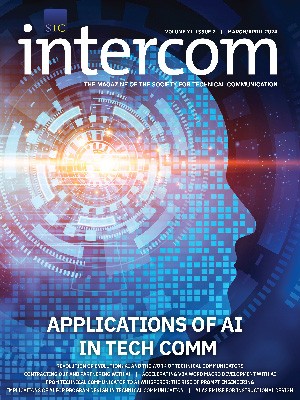Intercom Magazine Scope
Intercom is an online publication featuring articles of professional interest to technical communicators, including writers, editors, illustrators, teachers, managers, consultants, and other technical communication professionals of all levels. It provides practical applications and examples of technical communication that promote reader’s professional development.
If you have an idea for an article related to any practical aspect of technical communication, Intercom magazine would like to hear from you. Intercom accepts complete, unsolicited manuscripts from STC members and other industry experts. Before writing an article, look over several recent issues of the magazine to make sure your topic, scope, and approach are appropriate for our readers.
Articles featured in Intercom are approximately 1500–2500 words long, plus any images. You can also send us a short 100-word summary of your article idea, which enables our editorial staff to respond more quickly. It may also save you time in the event that another writer has already proposed a similar or recent article topic.
Learn more about our upcoming issues and scheduled topics from our Editorial Calendar at https://www.stc.org/intercom/editorial-calendar/.
Also, we are always looking for new columnists. If you have a theme that you can cover over multiple issues (usually two columns per year, approximately 1500 words each), contact us with your idea.
Manuscript Preparation
The purpose of Intercom is to inform. You should therefore write in a clear, informal style, avoiding jargon and acronyms. All decisions on style and usage should be guided by common sense: What is the clearest way to present the information practically to Intercom readers?
For Intercom, a good target length for submissions is 1500–2500 words, plus any images, tables, and/or figures. The editor reserves the right to edit an article to condense or expand material as appropriate to fit page and space limitations.
Our authority on spelling is Merriam-Webster’s Third New International Dictionary, Unabridged; on punctuation, usage, and format, The Chicago Manual of Style. All articles will be reviewed by STC editorial staff and/or professional copyeditors for adherence to these guidelines and Intercom style. Before publication, you will have an opportunity to review edits made to your submission.
Abstracts
Intercom articles typically include one or two sentence summaries, which are included in the magazine’s table of contents. Authors who do not provide their own abstracts will have one written for them by the editorial staff.
Formatting Manuscripts
All articles should be submitted as Microsoft Word files. Authors should put the title of the article in boldface at the top of the first page, followed by an optional subtitle or tagline. The next line should contain the name of the author(s) and their STC membership level(s) (Member, Senior Member, Associate Fellow, Fellow).
In general, Intercom publishes new material, however, if the article has previously appeared in another publication, the next line on the first page should state the name and date of that publication.
Within the body of the article, headings and subheads should appear in boldface. It is not necessary to use multiple fonts or columns when formatting a manuscript. Arial or any other sans-serif font is adequate. A professional designer will convert your manuscript to page proofs using Intercom appropriate style sheets.
Submitting Graphics with Your Manuscript
All graphics can be embedded in the manuscript or submitted as separate files, provided they are in JPG format and are at least 300 dpi (or higher) in resolution. Authors should use callouts to indicate the spot in the manuscript where a graphic should be inserted (usually indicated as a note in brackets, for example, [see Figure 1.]) and supply an appropriate caption.
Intercom staff are unable to change the quality, readability, or resolution of an image that you send. We cannot create, touch up, or recreate your graphics. If we receive a low-quality graphic, we will ask you to submit an alternate or improved version, if available, or request you remove the graphic altogether.
Screen captured images should be provided at the size they were created (100%). Please do not resample, enlarge, reduce, convert, or alter them in any way. If you would like to combine or crop graphics, you can add a note in brackets that describe how it should appear.
Photos should be submitted in full color and rendered at a size appropriate for use on a standard magazine page. When using a digital camera to take photos, please use the highest quality setting possible for both resolution and compression.
References
Intercom is a magazine and not an academic journal; therefore, articles do not include footnotes, but many authors like to include references that readers can pursue for additional information.
At the end of their articles, authors should include a list of references for cited materials, and optionally, they can include a list of suggested readings. The selected sources should provide readers more detailed information on topics discussed in the article.
In-text citations, suggested readings, and the list of references should be formatted following the styles defined in The Chicago Manual of Style.
Below are two examples on formatting citations from the Chicago Manual of Style, 17e, (p. 753 and 755):
Book
Format: Last, First, and First Last. Book Title. Location: Publisher, year.
Example: Grazer, Brian, and Charles Fishman. A Curious Mind: The Secret to a Bigger Life. New York: Simon & Schuster, 2015.
Journal article
Format: Last, First. “Article Title.” Publication vol, issue no. (Month year): pp–pp.
Example: Bagley, Benjamin. “Loving Someone in Particular.” Ethics 125, no. 2 (January 2015): 477–507.
Author Biographies
At the end of each article, include a 50–100-word biography, email address, and a headshot photo (JPG format) for each author.
Article Submission
The easiest way to submit an article to Intercom is by email to intercom-editor@stc.org. Depending on publication schedules, it can take two or three weeks for you to receive editorial feedback on your manuscript.
Publishing Rights
Authors retain copyright to their work in Intercom. The Society for Technical Communication (STC) requires that authors grant STC reprint rights to articles appearing in Intercom. The Society requires that authors grant STC permission to reproduce the article for an indefinite period in any media. We also ask authors to wait six months before re-publishing an Intercom article elsewhere (such as on a personal blog). After an article has been accepted for publication, authors will be asked to sign and submit a Licensing Agreement.
Contact Intercom
Please email us at intercom-editor@stc.org with any questions or original submissions.


